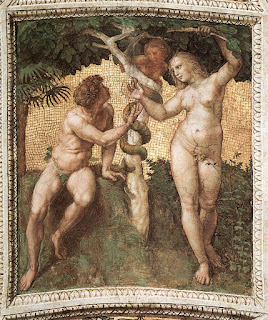In my interpretation of Titian’s “Sacred and
Profane Love” I identified the subject of the mysterious painting as the
“Conversion of Mary Magdalen.” Seeing the painting as a “sacred subject” opened
the way to an explanation of the figures on the equally mysterious relief. In a
post last week I showed that even the greatest scholars had been unable or
unwilling to deal with the figures on the relief.
Last week I discussed the two figures immediately
to the right of center and identified them as Cain and Abel. It was not
difficult to show that the image of a man in the act of delivering a blow to
another man lying prone on the ground was the common way of depicting Cain’s
murder of his brother. Titian himself used the same template years later.
In this post I will turn to the two nude
figures to the right of Cain and Abel. How is it possible that scholars and
others have never been able to identify the nude man and woman standing around
a tree as Adam and Eve? What other woman is ever portrayed in full frontal
nudity standing by a tree other than Eve. It is a little more difficult to see
Adam but if we look closely we see him there on the other side of the tree.
The image of Adam and Eve standing around the
tree at the moment of the Fall was probably ubiquitous during the Middle Ages
and the Renaissance. It was sculpted on exterior walls and on the interiors of
churches and baptistries. Here is an example from the exterior of the Doge’s
palace in Venice.
A quick search of the web will also reveal Adam
and Eve around the tree on some famous paintings. In the Brancacci chapel
Masaccio painted the expulsion
from the garden but Masolino, his associate, portrayed the first couple completely
nude by the Tree of the Knowledge of Good and Evil right before the Fall.
Later Raphael used the same motif in the Stanze.
Finally, here is a Titian depiction of Adam and Eve around the tree from around 1550. (Prado)
How have scholars not been able to see
Adam and Eve on the relief of the “Sacred and Profane Love”? In his classic study of the art and
iconography of the Middle Ages Emile Male noted a similar problem in his own
time. He raised the issue in a discussion of carved calendars on famous Medieval
cathedrals.
The most beautiful carved calendars are at Chartres, Paris, Amiens, and Reims. They are works of true poetry. In these small scenes, man appears in eternal attitudes. The artist probably intended to represent the peasant of France, but it is also a man of all time, bent toward the earth, the immortal Adam. In their universality, these thirteenth-century reliefs avoid banality. The artists, who themselves did not live far from nature, had experienced this life in all its detail, for just beyond the walls of small medieval towns lay the real country with its tilled fields, its meadows, the beautiful rhythm of its Virgilian labors…when sculptors were imagining scenes of rustic life, they had only to look around them for models….
It is hard to believe that the obvious meaning of these scenes escaped early nineteenth-century archeologists. In 1806, Lenoir interpreted the twelve scenes illustrating the calendar of the cathedral of Cambrai as the twelve labors of Hercules. Dupuis, author of L’Origine de tous les cultes, did identify the signs of the zodiac on the façade of Notre-Dame of Paris, but from this he concluded that the cult of the sun or of Mithra had survived into the thirteenth century. *
Even today scholars and students expend enormous amounts of time and energy trying to find the equivalents of Hercules and Mithras in some of the most beautiful paintings of the High Renaissance. I believe that they are often looking in the wrong place, and often fail to see what would have been obvious to any Venetian artist, patron and even man in the street. ###
* Emile Male: Religious Art in France, the Thirteenth Century, Princeton, 1986, p. 69.






No comments:
Post a Comment